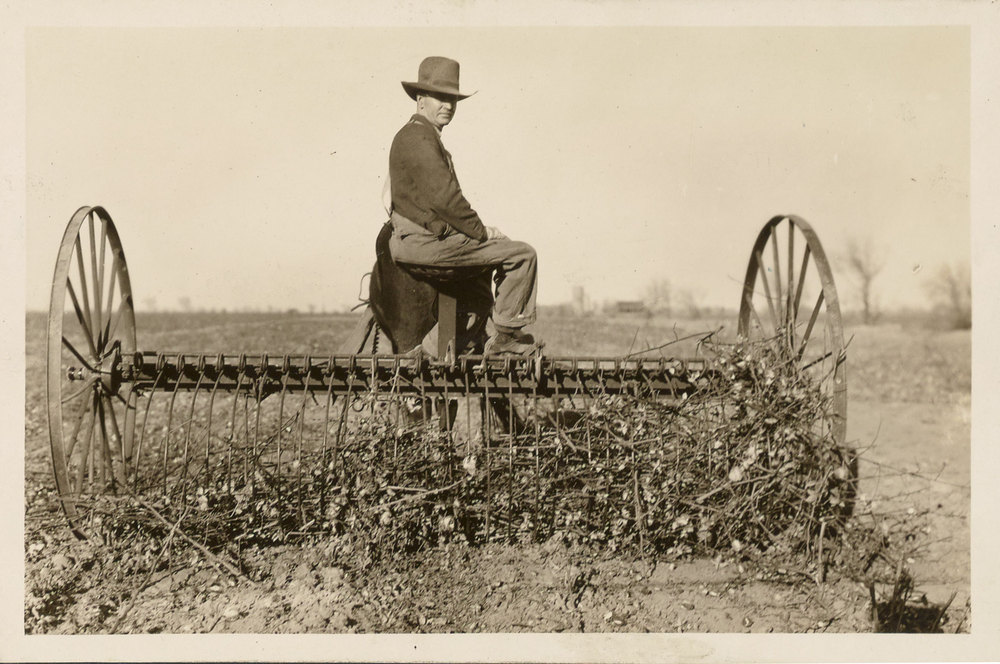Historians consider 1936 the year that the Dust Bowl officially ended. Millions of tons of topsoil had been stripped from Great Plains farms. The country was still reeling from the Great Depression. The peak years of migrations of desperate farmers from Oklahoma, Arkansas and other Dust Bowl states to California still lay ahead.
In that year the federal government’s Resettlement Agency, working with a $6,000 budget provided by the New Deal Agency, produced and released a 25-minute-long documentary film, The Plow That Broke The Plains. It purported to explain the roots of the farm crisis and was widely shown in theaters. Pictured above is from Pink Bollworm Project Photograph Collection courtesy of the U.S. Department of Agriculture.
It’s well worth watching today as a work of art. It has bare-bones narration and consists mostly of striking images with a beautiful score by American composer Virgil Thompson. You can view it at https://www.youtube.com/watch?v=8uEwGmjhquU.
Its message is artfully conveyed with images of massive farm machinery sweeping across wheat fields, intercut with spouting Wall Street ticker tape and frenetic jazz bands. The message is that greedy farmers caused the Dust Bowl by overexploiting the land with technology during the 1920’s go-go years and needed to be rescued by the federal government.
There was a grain of truth there. Farm production did greatly expand during and after World War I. However, farm prices crashed after the war. Agriculture was becoming more efficient due to technology, requiring fewer hands and accelerating the migration of farm labor to cities during the 1920s. Soil conservation practices were not what they are now.

But did farmers really “cause” the Dust Bowl? Many of their troubles came from government itself, which during World War I had urged expanded production—”Wheat will win the war.” Farmers had nothing to do with the protectionist Smoot-Hawley Tariff Act of 1930. The reactions of other countries to that act hit farm exports, which in 1933 were down by one-third from their 1929 peak.
The two men most responsible for the film were Henry Wallace, FDR’s Secretary of Agriculture, and Rexford Tugwell, an assistant secretary of agriculture (later undersecretary) and economist whom Time magazine was called the “top man” of FDR’s Brain Trust. Both men were said to be committed socialists who believed that markets were inherently flawed and that the state should direct the economy. Tugwell’s Agricultural Adjustment Administration, which he helped create, initiated the policy of paying farmers to take land out of production to support farm prices.
In 1933 farmers still made up almost a quarter of the U.S. population. Almost every family had members or relatives that farmed. That made the farm vote very important. Tugwell’s (and therefore FDR’s) policy was to boost farm incomes by restricting and regulating supply—taking land out of production when prices got too low and releasing commodities from government stockpiles acquired at guaranteed prices when they got too high. Overall, though, that support for farmers came at the expense of consumers, for whom food prices remained relatively high for the next few decades.
The supply-restriction New Deal policies of Wallace and Tugwell lasted until Earl Butz, Richard Nixon’s Secretary of Agriculture in 1971. By then the U.S. farm population had shrunk to 4.1% and the farm vote was less important. Russian crop failures in 1973 sent its wheat buyers to the U.S., where they made massive purchases and drove up wheat prices. Nixon told Butz to keep food prices low for consumers at all costs.
Butz scrapped New Deal supply regulation policies and reoriented crop price supports and farm loan policies toward encouraging growers to “Get big or get out,” as he famously (or notoriously) put it. Instead of supply restrictions and higher domestic food prices, foreign sales of surpluses were now going to be the guarantor of farm incomes.
Thirty-five years after The Plow That Broke the Plains, high production was king again.
David Murray can be reached at [email protected].




